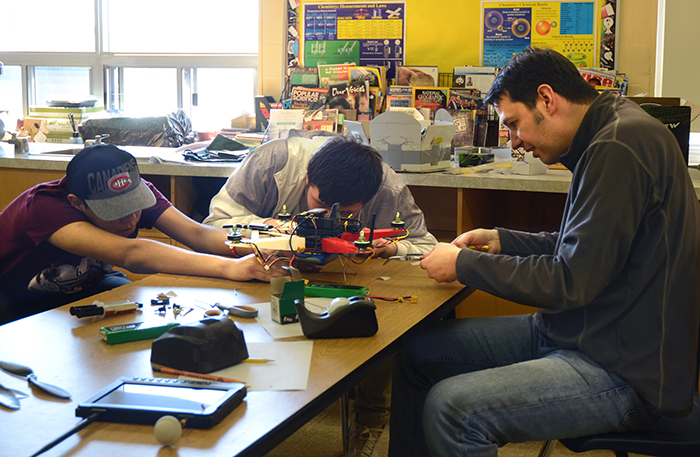
This spring, a team of researchers from the University of Toronto Institute for Aerospace Studies (UTIAS) partnered with Dennis Franklin Cromarty High School (DFC), a high school in Thunder Bay, Ont. serving Indigenous students from communities in northern Ontario. The researchers delivered a series of online and in-class workshops aimed at teaching Grade 10 science students how to build a quadrotor drone.
The initiative was spearheaded by professors Craig Steeves and Jonathan Kelly (both UTIAS) and included graduate students Rikky Duivenvoorden (EngSci 1T3 + PEY, MASc UTIAS 1T6), Chris McKinnon (EngSci 1T3, MASc UTIAS 1T5, PhD candidate), Bharat Bhaga (UTIAS PhD candidate) and Suraj Bansal (UTIAS PhD candidate). The program was made possible by support from the Dean’s Strategic Fund for the Centre for Aerial Robotics Research and Education (CARRE).
“The CARRE funding enabled us to develop a program where Indigenous high school students would get some exposure to the technology of drones—ideally, to understand what the drones can do, what they can’t do and how they are designed and constructed,” said Steeves.
Sharon Angeconeb, the school’s principal, and Matt Kaskiw, the school’s Grade 10 science teacher, were supporters of the program and keen to get it off the ground as early as possible.
“This was huge for us in terms of technology — it’s something lacking up north. To have professors from U of T spend time with the students was truly amazing. I can’t put it into words,” says Principal Angeconeb. “Assembling a drone sparked the interest of the students and was something they could learn more about and teach their younger siblings. It also expanded their opportunities for post-secondary education.”
Through weekly online workshops, Steeves and his team taught the students the technical background and steps to designing a drone. This included selecting propellers, batteries, motors and an autopilot, and designing some of the drone structure.
In keeping with the philosophy of the school’s namesake, Dennis Franklin Cromarty, the program offered an opportunity for the students to learn new skills that they could bring back to their northern communities.
“If you look longer term, you can image that drones are likely to be used more often in remote northern areas of Canada for monitoring things like resources, wildfires or wildlife, for search and rescue, or for delivery of small packages, like medicines,” said Steeves. “With an understanding of how drones are built and operated, the students will be better placed to ensure that drones are used to the benefit of their communities.”
In early April 2018, the UTIAS team travelled to Thunder Bay to build the first drone. The students built a drone using the parts they selected and conducted a flight test at the basketball court behind the school.
“The most rewarding part of the program was working with the students to build the drone and to finally see it fly above the basketball court with their help,” said Duivenvoorden.
After dedicating many hours to working on the drone, the students and their science teacher, Matt Kaskiw, were also excited to see their work come to life.
“This was an awesome collaboration and something the students and I wouldn’t usually have an opportunity to work on,” says Kaskiw. “I was really happy to get such positive feedback from the students, and it was a very rewarding experience, especially since the program has an application up north.”
It wasn’t all smooth flying for the UTIAS team — and the instructors learned as much as they taught, said McKinnon. The students also inspired the researchers’ approach their future work.
“Working with the students taught me how to effectively convey complex ideas in a way that’s relatable to their own real-world experiences,” says Bansal. “This will definitely prove to be a valuable lesson for me in the future whether I’m training new students in the lab, collaborating with undergraduate students or presenting at conferences.”
Bhaga also found a direct connection between preparing lectures for the students and completing his PhD thesis.
“This experience taught me the importance of simplifying complicated concepts for audiences outside academia,” says Bhaga. “For my thesis, I spend a lot of time making diagrams so something is easier to understand, and I’ve gone back and revised some of these diagrams after working with the students.”
Steeves hopes to expand the program to other Indigenous high schools in Ontario. He also has plans to invite the students and their teacher to Toronto to take them on a tour of the leading-edge aerospace engineering facilities at UTIAS.
Steeves is also excited to be working on a special project to bring back to the school.
“Early in the planning stages, I asked Principal Angeconeb what sort of thing she would like to see come out of the program. The first thing she said was a birch bark drone,” said Steeves. “One of the projects I’m working on is how to make a birch bark composite.”




